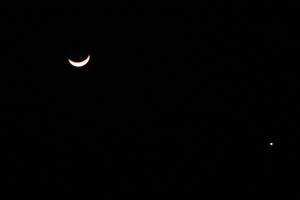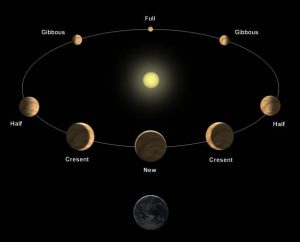The other day while coming in during the early evening hours, I spy an abnormally bright star, so bright it just had to be a planet! Have you noticed it? Typical of me, I do not follow the timing of planet visibility. I prefer the sense of discovery; being surprised. As soon as you have a clear night, go outside shortly after sunset, look to the west and I will bet you see what I saw.
Scientist and serious skygazers have known the planets schedules for centuries. Like the Earth, other planets circle the sun on a fixed schedule. From almost the beginning of time, people notices that a few stars wandered across the sky, unlike most stars which moved in lockstep with all of their companions. The Greeks gave these objects a name that means “wanderer.”1
Seeing this bright light in the sky and wondering what it could be, I got out my spotting scope and took a look. As soon as it came into focus, I knew I had Venus in my sights. I could identify Venus not only because of its brilliance, but because the image in my small telescope was a semicircle, not a circle. The Romans named each of the five visible planets after one of their gods or goddesses—Mercury, Venus, Mars, Jupiter, and Saturn. For the brightest object in the sky after the sun and moon they chose the named Venus after their goddess of love and beauty.

Babylonians, Egyptians, Greeks and Mayans are among the cultures that tracked the stars and the visible planets. So this planet has no one credited as its discoverer. The Mayan’s tracked Venus very closely.2 They recognized that Venus had regular patterns that extended over a period of years. They realized that it takes 584 days for Venus and the Earth to line up together so they are in the same space, it takes 2,922 days (about 8 years) for the Sun, Earth, and Venus to align. Some of the Mayan monuments were built specifically to align with Venus so the astronomers could follow the planet more closely. In their culture Venus and Jupiter dictated the time for war and the time for changes of power.
In 1514, Nicholaus Copernicus theorized the Earth and planets circled the sun—a heliocentric solar system—not the Earth—a homocentric solar system. He wrote a small book outlining the geometry behind this observation, a book he shared his only with his friends. Just prior to his death in 1543, he made the publication public. De Revolutionibus Orbium Coelestium (“On the Revolutions of the Heavenly Spheres”). His contribution to science took almost 100 years to see the light of day and just barely.
In 1610, Galileo added Venus to the objects he viewed through his newly built, albeit crude, telescope.3 He saw exactly what I did, a star that, unlike the stationary stars, actually looked larger in his telescope and was not a complete circle. After multiple observations, he noticed that Venus passed through phases like the moon.4 He understood that this meant that Venus circled the sun and not the Earth. Galileo confirmed Copernicus’s theory through rigorous scientific study—heresy. Galileo risked excommunication and the inquisition. Grilled, imprisoned and placed under house arrest, Gallileo waltzed around and obfuscated when queried about why his observations did not rise to heresy. Ever conscious that he risked his life, he still stood up to the powers that be to reveal the truth.5 What a remarkable mind! I doubt I would have ever figured that out without the benefit of all my modern schooling.
Anyone can recreate Galileo’s discovery by watching Venus’s phases. You do not need a fancy telescope, Galileo’s creation had only a 30 power magnification and Venus can be viewed through binoculars. After you watch for serval weeks, you will notice that like the moon, Venus goes through phases. This image taken from the One Minute Astronomer lets you visualize how this works.


Until the middle of March 2017, Venus shines early in the evening shortly after sunset—an evening star. Being fairly close to the Earth, it appears its brightest even though a small crescent on February 14, 2017.6 Then after being hidden by the bright light of the sun, in late-March it reappears and remains as a morning star through the rest of the year. So, if you are like me, not a morning person, now is the time to go out and look at this spectacle.
Whenever I notice an abnormally bright star, I grab my binoculars or a telescope and take a look. If it grows larger (stars don’t) I attempt to identify which planet I see. I use the following clues. If it has phases, it is either Venus or Mercury as both revolve between the Sun and Earth. If red, it is Mars. If you see little stars lined up along the equator of the planet, you have Jupiter. Saturn is fascinating with its rings that also change positions relative to the Earth. Try it! When you get the chance, do not do it just once, but over a series of days or each time you see the planets. The changes are remarkable to follow.
References and places to learn more:
1. Read an English translation of Copernicus’s book, On the Revolution the Heavenly Spheres book 1 at http://www.geo.utexas.edu/courses/302d/Fall_2011/Full%20text%20-%20Nicholas%20Copernicus,%20_De%20Revolutionibus%20(On%20the%20Revolutions),_%201.pdf
2. Learn more about the Mayan Venus calendar at http://www.chichenitza.com/listingview.php?listingID=49 and http://www.authenticmaya.com/maya_astronomy.htm and http://www.oocities.org/athens/delphi/9976/01vtdrought.html
3. Background on Venus’s early discoveries can be found at http://www.universetoday.com/38143/who-discovered-venus/
4. Source of image above – http://oneminuteastronomer.com/5326/phases-v
5. Galileo’s Daughter by Dava Sobel is a great read about Galileo’s life and struggles.
6. Date of Venus visibility – https://www.timeanddate.com/astronomy/night/ or https://in-the-sky.org/news.php?id=20170112_12_100

Another good one, Merce! Keep them coming, my good man.
Love this stuff. Keep it up!
Fascinating reading. Thank you, Bob!
I loved your article.Really thank you! Cool.